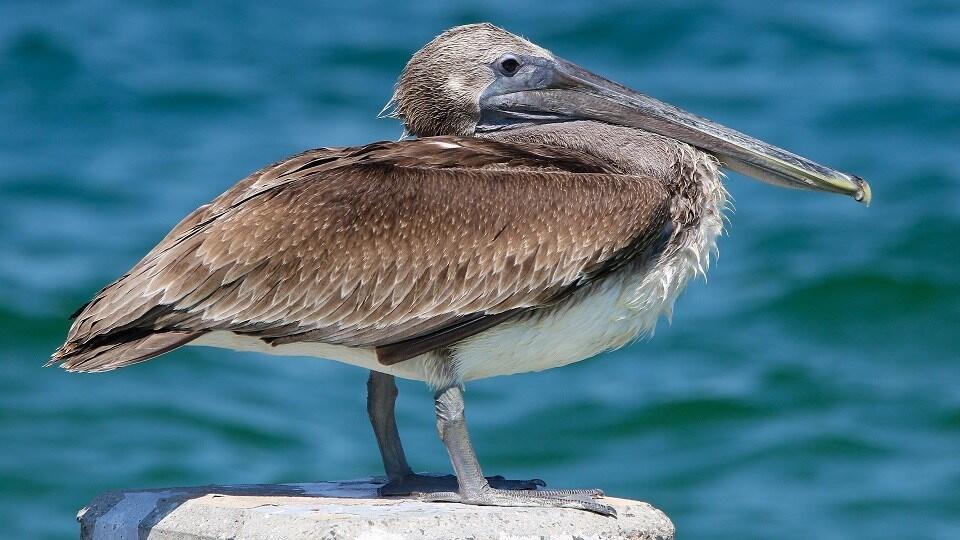
Caption
The brown pelican is among the species protected by Georgia's bird island rule, which prohibits public access to certain coastal islands and sandbars.
Credit: National Park Service
LISTEN: Regulators are proposing updates to Georgia's "bird island rule" to add new protected nesting sites for seabirds and shorebirds while removing areas that have eroded. GPB's Benjamin Payne reports.

The brown pelican is among the species protected by Georgia's bird island rule, which prohibits public access to certain coastal islands and sandbars.
The Georgia Department of Natural Resources is proposing its first-ever change to a nearly 30-year-old regulation that protects threatened seabirds and shorebirds from human disturbance at critical nesting sites along the coast.
Georgia's "bird island rule," enacted in 1998, currently prohibits public access to three sandbar islands — Egg Island Bar, Satilla River Marsh Island, and St. Catherines Island Bar — and restricts access to portions of two others, Williamson Island and Pelican Spit.
The proposed amendments would add several new locations to the protected list while removing sites that have eroded or merged with larger landmasses due to the dynamic nature of Georgia's coastal environment.
DNR wildlife conservation program manager Timothy Keyes said the changes are necessary because these habitats are often highly ephemeral and shift over time.
"Of the original sites named in the bird island rule, some have basically just disappeared, have merged with the uplands, just have become less important nesting sites, and other sites have emerged as important," Keyes said.
The rule was created to protect isolated sandbar islands that provide ideal nesting conditions for colonial seabirds and shorebirds because they lack mammal predators like coyotes, raccoons, and foxes that prey on ground-nesting birds.
Keyes explained that these small offshore islands represent some of the most productive nesting habitats but are also extremely vulnerable to human disturbance.
"A nice little sandbar island — which might look like a great place to pull the boat and spend the Saturday — if there's seabirds nesting there, you're basically keeping birds off their eggs or small chicks," he said.
Several species are protected under the rule, including American oystercatchers and Wilson's plovers among shorebirds, and royal terns, Sandwich terns, brown pelicans, gull-billed terns, black skimmers, and least terns among seabirds.
The most significant addition would be Brunswick Bird Island in Glynn County, created by the U.S. Army Corps of Engineers in 2007 using dredge spoil from the deepening of Brunswick Harbor and designed specifically as bird habitat.
The artificial island now hosts approximately 8,000 nesting pairs of seabirds, Keyes said, including state-threatened gull-billed terns and Wilson's plovers, but lacks the enforcement protections of the original rule.
Other sites proposed for addition include Ogeechee Bar in Chatham County near Raccoon Key and Ossabaw Island, which supports extensive horseshoe crab spawning and serves as one of Georgia's most important sites for federally threatened red knots, with more than 4,000 observed there in May.
The proposal also includes Cumberland Dividings, a bird island in Camden County created in 2024 by the Army Corps of Engineers near Cumberland Island, as well as provisions for protecting future dredge spoil islands and naturally emerging sandbars.
Several original sites would be removed from protection due to environmental changes, including Pelican Spit in Glynn County, which has merged with Sea Island and is no longer used by nesting seabirds.
St. Catherines Island Bar in Liberty County has been "seriously degraded" by flooding that destroys nests and eggs, according to the DNR, while Little Egg Island Bar in McIntosh County has nearly merged with Egg Island, allowing raccoon access that makes it unsuitable for colonial seabirds.
Hurricane Matthew in 2016 removed all suitable nesting vegetation on Satilla River Marsh Island in Camden County, transforming it from a site that hosted a nesting colony of brown pelicans and egrets into a marsh island that now hosts nesting American oystercatchers but no colonial waterbirds.
The proposed changes would establish seasonal closures generally from April 1 through Aug. 31, when the sites would be posted as closed during nesting season, while allowing public access during other times of the year.
Pets would remain prohibited year-round at all sites covered under the rule, as dogs have been responsible for significant nest destruction in previous years.
On Memorial Day weekend in 2024, people and dogs on Ogeechee Bar caused the depredation of at least seven black skimmer nests and the death of two least tern chicks, according to the DNR, while likely causing many more eggs to overheat and be lost when adults were scared off their nests.
The DNR is conducting public "scoping" sessions to gather input on the proposed changes, with 6 p.m. meetings scheduled for July 16 in Brunswick at the Susan Shipman Environmental Learning Center, July 29 in St. Marys at Crooked River State Park, and Aug. 6 in Savannah at Skidaway Island State Park.
Comments can also be submitted by email to wcscomments@dnr.ga.gov, by phone at 912-264-7355, or by mail addressed to Timothy Keyes, Georgia Department of Natural Resources Wildlife Resources Division, Wildlife Conservation Section, One Conservation Way, Suite 310, Brunswick, GA 31520.
The deadline for public comments is 4:30 p.m. on Aug. 22. The Georgia Board of Natural Resources is scheduled to consider the proposed changes during its Sept. 23 meeting in Brunswick.
Keyes said that the rule changes aim to balance conservation with recreational opportunities, noting that the protected sites represent a small fraction of coastal areas available to the public.
"We're basically trying to thread the needle between protecting these birds, allowing them to thrive," he said, "while allowing recreational opportunities as well."